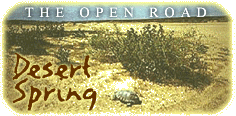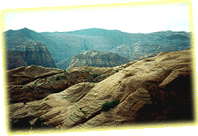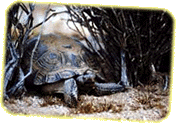 |
 |
 |
|
|||
|
Desert Spring
Tortoises are so rare they are protected. They can grow up to 15 inches in diameter, and can live to be 80 or 90 years old. The ultimate desert inhabitants, they can store water in their bladders and absorb it later, sort of like camels with their humps; they can survive heat of up to 140 degrees because of their ability to burrow. In fact, they spend up to 95 percent of their lives underground, which is one reason why they are so hard to spot. But springtime, before the weather gets too hot, is a good time to look, if we only knew how to go about it. We haven't been able to find a tortoise hotline, so we decide to simply strike out on our own, driving across the Mojave from Salt Lake City to Las Vegas.
"Desert tortoises?" they say when we ask. No, they haven't seen any here, but they did spot one a few days ago on the red rocks above the St. George golf course. So we head into St. George, scramble over the cliffs that ring the municipal golf links. We are looking under rocks and bushes, anyplace a tortoise might shade up from the afternoon sun. We find what looks like a burrow. We get a momentary thrill when we think we spot an egg nestled in a patch of globemallow, but it turns out to be a golf ball. Which reminds us: most people around here think of something other than desert tortoises when their thoughts turn to spring. We hit the road again, a back route over the Beaver Dam Mountains. On the west slope, we turn off onto a bumpy dirt road through the Joshua trees. Joshuas are those queer little desert trees that have four or five thick arms ending in spiky tassels. They look like they just arrived from another planet. It seems like good tortoise habitat to us, but the wind has come up and it's so dry that our water bottles seem to evaporate before we can even get them to our mouths. We poke around in a desultory way but start thinking about shading up ourselves.
There's an owl way out there somewhere in the distance, and the rush of traffic on the interstate a long way off sounds sort of like the ocean. Once, we hear something we think might be the scratching of a desert tortoise, but it's just the ticking of our car engine as it cools. At last, it's back into the car, defeated. We decide to head into Las Vegas for the night, and turn on public radio for solace. We're beginning to think that we're going about this all wrong. Tortoises on the golf course and in the streets of Las Vegas? Maybe we should just wait for one to call us on the cell phone. But then, we always knew that the desert is full of mirage and surprise, most especially in the spring.
Web Sites for Desert Tortoises:
Snow Canyon on the Web: |
 | American Public Media Home | Search | How to Listen ©2004 American Public Media | Terms of Use | Privacy Policy |

 It's spring and my husband Hal and I have been calling up
wildflower hotlines and scouring the internet, all to plan our annual
excursion to the desert. Spring in the desert is elusive and
unpredictable, not at all like more gentle climes where you can depend
on tulips or cherry trees blooming at some particular time. Everything
has to be just right for the desert to flower: the soil, the rainfall,
the temperature - one area might explode in profusion while a couple of
miles away, things are dry as a bone. Each year, Hal and I choose a
particular plant we want to find in bloom, and we've gotten pretty good
at gathering the information we need to get us to the right place at the
right time. But this year we've decided to go for gold: we want to find
a desert tortoise as it comes out of hibernation.
It's spring and my husband Hal and I have been calling up
wildflower hotlines and scouring the internet, all to plan our annual
excursion to the desert. Spring in the desert is elusive and
unpredictable, not at all like more gentle climes where you can depend
on tulips or cherry trees blooming at some particular time. Everything
has to be just right for the desert to flower: the soil, the rainfall,
the temperature - one area might explode in profusion while a couple of
miles away, things are dry as a bone. Each year, Hal and I choose a
particular plant we want to find in bloom, and we've gotten pretty good
at gathering the information we need to get us to the right place at the
right time. But this year we've decided to go for gold: we want to find
a desert tortoise as it comes out of hibernation.
 Our first stop is the Snow Canyon State Park, near St. George, Utah, a
site suggested to us by a desert field-biologist. We park at a
trailhead just as a group of tourists returns to their car.
Our first stop is the Snow Canyon State Park, near St. George, Utah, a
site suggested to us by a desert field-biologist. We park at a
trailhead just as a group of tourists returns to their car.
 Okay, we admit it. We stop at one of the casinos in Mesquite, on the
Nevada border, dawdle over big Cokes and maybe just a few pulls on the
slot machine. It's night now, and we're speeding across the desert to
Las Vegas. The full moon overhead is so bright that it casts shadows,
and it's nice and cool, so we decide to try one more time to locate a
tortoise. We turn off on a gravel road, drive a couple of miles, and
get out to look around.
Okay, we admit it. We stop at one of the casinos in Mesquite, on the
Nevada border, dawdle over big Cokes and maybe just a few pulls on the
slot machine. It's night now, and we're speeding across the desert to
Las Vegas. The full moon overhead is so bright that it casts shadows,
and it's nice and cool, so we decide to try one more time to locate a
tortoise. We turn off on a gravel road, drive a couple of miles, and
get out to look around.
